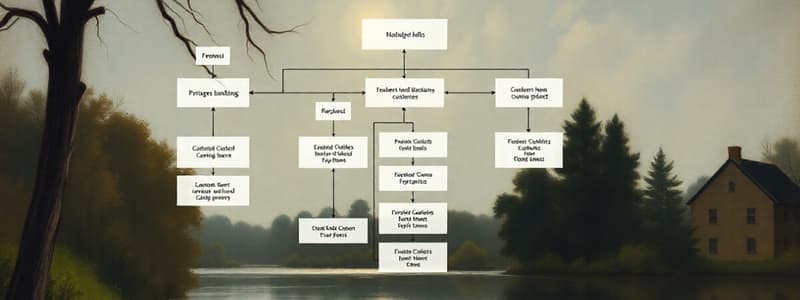Podcast
Questions and Answers
What is the primary purpose of low-level design in software engineering?
What is the primary purpose of low-level design in software engineering?
- To define the overall structure and components of a software system.
- To develop test cases for verifying the software's correctness.
- To analyze the user requirements for the software system.
- To create a detailed plan for implementing the software's functionality. (correct)
Which of the following is NOT a key task in low-level design?
Which of the following is NOT a key task in low-level design?
- Creating detailed design.
- Developing user interface prototypes. (correct)
- Evaluating detailed design.
- Understanding architecture and requirements.
Which design principle is crucial for both architectural and detailed design?
Which design principle is crucial for both architectural and detailed design?
- Encapsulation.
- Inheritance.
- Cohesion. (correct)
- Abstraction.
Which UML diagram is used to represent the flow of events and interactions between objects in a system?
Which UML diagram is used to represent the flow of events and interactions between objects in a system?
How does low-level design relate to the waterfall model?
How does low-level design relate to the waterfall model?
Which of the following is NOT a common data structure used in low-level design?
Which of the following is NOT a common data structure used in low-level design?
What is the primary purpose of "interface design" in low-level design?
What is the primary purpose of "interface design" in low-level design?
Which of the following is a benefit of using low-level design in software development?
Which of the following is a benefit of using low-level design in software development?
Which of the following techniques is NOT used within "Interface design (internal)" as described in the content?
Which of the following techniques is NOT used within "Interface design (internal)" as described in the content?
What is the primary purpose of defining a ring buffer within the context of "Interface design (internal)" as described?
What is the primary purpose of defining a ring buffer within the context of "Interface design (internal)" as described?
Which of the following is NOT considered an advantage of concurrency in "Interface design (internal)"?
Which of the following is NOT considered an advantage of concurrency in "Interface design (internal)"?
What is the key challenge associated with "Race conditions" in the context of concurrency?
What is the key challenge associated with "Race conditions" in the context of concurrency?
In "Interface design (external)", what is the primary concern when designing communication between devices and users?
In "Interface design (external)", what is the primary concern when designing communication between devices and users?
Which of the following is NOT a key component of data communication within "Interface design (external)"?
Which of the following is NOT a key component of data communication within "Interface design (external)"?
Which operating system exhibits the highest market share on laptop/desktop devices according to the provided data?
Which operating system exhibits the highest market share on laptop/desktop devices according to the provided data?
What is the primary focus of "GUI design" as described in the content?
What is the primary focus of "GUI design" as described in the content?
Which of the following is a key task in detailed design, according to the content?
Which of the following is a key task in detailed design, according to the content?
What are the two primary types of UML diagrams used for internal component design?
What are the two primary types of UML diagrams used for internal component design?
Which data structure is considered Last-In-First-Out (LIFO)?
Which data structure is considered Last-In-First-Out (LIFO)?
What type of review is the most common method for evaluating detailed design?
What type of review is the most common method for evaluating detailed design?
What is the difference between a "Software Design Document" and a "Software Detailed Design"?
What is the difference between a "Software Design Document" and a "Software Detailed Design"?
Which of the following is a component of a typical detailed design document?
Which of the following is a component of a typical detailed design document?
Why is it important to define data types carefully during detailed design?
Why is it important to define data types carefully during detailed design?
According to the content, what is the recommended approach for evaluating detailed design?
According to the content, what is the recommended approach for evaluating detailed design?
Flashcards
Low-level design
Low-level design
The process of refining architecture into detailed specifications.
Key tasks in low-level design
Key tasks in low-level design
Understanding architecture, creating and documenting detailed design, and evaluating it.
Cohesion
Cohesion
The degree to which components of a module belong together.
Coupling
Coupling
Signup and view all the flashcards
Race condition
Race condition
Signup and view all the flashcards
UML diagrams
UML diagrams
Signup and view all the flashcards
Documenting detailed design
Documenting detailed design
Signup and view all the flashcards
Waterfall model
Waterfall model
Signup and view all the flashcards
Interface Design
Interface Design
Signup and view all the flashcards
Internal Interface Design
Internal Interface Design
Signup and view all the flashcards
Shared Memory
Shared Memory
Signup and view all the flashcards
Message Passing
Message Passing
Signup and view all the flashcards
Concurrency
Concurrency
Signup and view all the flashcards
External Interface Design
External Interface Design
Signup and view all the flashcards
Graphical User Interface (GUI)
Graphical User Interface (GUI)
Signup and view all the flashcards
WPF
WPF
Signup and view all the flashcards
UML Structure Diagram
UML Structure Diagram
Signup and view all the flashcards
Array
Array
Signup and view all the flashcards
Queue
Queue
Signup and view all the flashcards
Singly Linked List
Singly Linked List
Signup and view all the flashcards
Software Design Document (SDD)
Software Design Document (SDD)
Signup and view all the flashcards
Technical Reviews
Technical Reviews
Signup and view all the flashcards
Incorrect Data Type
Incorrect Data Type
Signup and view all the flashcards
Study Notes
CP317 Software Engineering - Week 4-1: Low-Level Design (Part 1)
- Course: CP317 Software Engineering
- Week: 4-1
- Topic: Low-level design (detailed design)
- Instructor: Shaun Gao, Ph.D., P.Eng.
- Agenda Topics:
- Review of week 3-2 topics (UML diagrams, race conditions, design principles of decomposition, cohesion, and coupling).
- Low-level design concept and key tasks.
- Detailed design creation, including interface design (internal and external), GUI design, internal component design, data design, and documentation.
- Evaluating detailed design and managing implementation.
- Summary of low-level design.
Review of Week 3-2 Topics
- UML Diagrams: Unified Modeling Language diagrams, including structure diagrams (class diagrams, component diagrams), behavior diagrams (use case diagrams, state transition diagrams, sequence diagrams).
- Design Principles: Decomposition, cohesion, and coupling are critical for both architecture design and detailed design.
- Race Conditions: A situation where several processes try to access and modify the same shared resource at the same time, potentially leading to inconsistent results.
Low-Level Design (Detailed Design)
- Concept: Detailed design is the process of refining and expanding the software architecture to a level that allows implementation. It provides detailed specifications of internal components, including data structures, algorithms, and processing.
- Key Tasks:
- Understanding Architecture and Requirements: Thorough understanding of the system requirements and architecture is crucial for allocating components with the right responsibilities. This includes identifying cohesion and coupling properties within components.
- Creating Detailed Design: Designing the interface (internal and external), GUI, data design, and internal component structure are key for efficient software implementation.
- Interface Design (internal): Defines how components interact.
- Methods: Shared memory, concurrency, message passing, Inter-process communication (IPC).
- Interface Design (external): How the software interacts with external users, devices, or systems. Ex. GUI design, protocols like TCP/IP or serial (RS-232C), and microcontroller communication.
- GUI design: Graphical User Interface to provide users with an interactive way to interact with a system.
- Internal Component Design: Diagram showing internal component structure and behaviour including UML structure diagrams, class diagrams, component diagrams, UML behavior diagrams, use case diagrams, state transition diagrams, and sequence diagrams.
- Data Design: Defining data structures and types relevant to the software's components and functions.
- Data Structures: Arrays, stacks (LIFO), queues (FIFO), linked lists(singly and doubly).
- Documenting Detailed Design: Creating a Software Design Document (SDD) detailing design decisions, specifications, and components.
- Evaluating Detailed Design: Technical reviews to evaluate design for correctness, completeness, and efficiency using techniques like technical review meetings with time notice, input from technical expert, testing team, requirements validation.
- Managing Implementation: Includes creating an implementation plan, defining a model, and delegating tasks.
Specific Design Topics
- Shared Memory / Concurrency: Techniques for sharing data between multiple parts of a program concurrently, which may cause race conditions.
- Graphical User Interface (GUI) design: This is one way for Users to interact with a system's software.
- ASCII: Describes coding for communicating between devices which uses a code table (ASCII table) for unambiguous and well-understood character exchange and representation.
Software Design Documents (SDD)
- Table of Contents Example: A typical SDD includes sections like Introduction, Software Architecture, Detailed Design, and Conclusion. Sections like Date of Issue, Scope, Issue organization, Authorship, and References are also important.
Additional Information
- .NET & Programming Technologies: .NET is one language used for programming and in different versions (e.g., .NET Core 3) including in different environments like Desktops, Web programming or cross-platform capabilities.
- Waterfall model: A structured approach to implementing software, following a linear sequential flow.
- Technical reviews: A procedure for evaluating detailed design through structured review, making sure specifications, implementation design and requirements are correct and complete.
Announcement
- Group Formation: 75% of students have formed groups.
- Test 1: A test covering weeks 1-4 will be held on Feb 3rd, requiring laptop completion.
- Location: LH3094
Studying That Suits You
Use AI to generate personalized quizzes and flashcards to suit your learning preferences.




